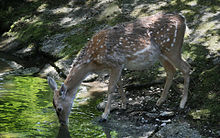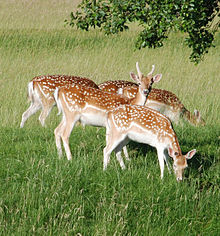- Fallow Deer
-
This article is about the deer genus. For other uses, see Dama (disambiguation).
Fallow Deer 
Male (buck) 
Female (doe) Conservation status Scientific classification Kingdom: Animalia Phylum: Chordata Class: Mammalia Order: Artiodactyla Family: Cervidae Subfamily: Cervinae Genus: Dama Species: D. dama Binomial name Dama dama
(Linnaeus, 1758)
Range
1: Native
2: Possibly native
3: Early human introductions
4: Modern human introductionsThe Fallow Deer (Dama dama) is a ruminant mammal belonging to the family Cervidae. This common species is native to western Eurasia, but has been introduced widely elsewhere. It often includes the rarer Persian Fallow Deer as a subspecies (D. d. mesopotamica),[2] while others treat it as an entirely different species (D. mesopotamica).[1]
The male is known as a buck, the female is a doe, and the young a fawn. Adult bucks are 140–160 cm long and 85–95 cm shoulder height, and 50–80 kg in weight; does are 130–150 cm long and 75–85 cm shoulder height, and 25–45 kg in weight. Fawns are born in spring at about 30 cm and weigh around 4.5 kg. The life span is around 12–16 years.
The species has great variations in the colour of their coats, with four main variants, "common", "menil", "melanistic" and "white" - a genuine colour variety, not albinistic.[3] The white is the lightest colored, almost white; common and menil are darker, and melanistic is very dark, sometimes even black (easily confused with the Sika Deer).
Common: Chestnut coat with white mottles that are most pronounced in summer with a much darker, unspotted coat in the winter. Light-colored area around the tail, edged with black. Tail is light with a black stripe.
Menil: Spots more distinct than common in summer and no black around the rump patch or on the tail. In winter, spots still clear on a darker brown coat.
Menalistic/Black: All year black shading to greyish-brown. No light-colored tail patch or spots.
White (not albino): Fawns cream-colored, adults become pure white, especially in winter. Dark eyes and nose, no spots. [4]Most herds consist of the common coat variation, yet it is not rare to see animals of the menil coat variation. The Melanistic variation is rarer and white very much rarer still.
Only bucks have antlers, which are broad and shovel-shaped (palmate) from 3 years. In the first two years the antler is a single spike. They are grazing animals; their preferred habitat is mixed woodland and open grassland. During the rut bucks will spread out and females move between them, at this time of year fallow deer are relatively ungrouped compared to the rest of the year when they try to stay together in groups of up to 150.
Agile and fast in case of danger, fallow deer can run up to a maximum speed of 28 mph (45 km/h) over short distances (being naturally less muscular than other cervids such as roe deer, they are not as fast). Fallow deer can also make jumps up to 1.75 metres high and up to 5 metres in length.
Contents
Distribution and history
The Fallow Deer is a Eurasian deer[5] that was a native to most of Europe during the last Interglacial. In the Holocene, the distribution was restricted to the Middle East and possibly also parts of the Mediterranean region, while further southeast in western Asia was the home of the Persian Fallow Deer, that is bigger and has larger antlers. In the Levant, Fallow Deer were an important source of meat in the Palaeolithic Kebaran-culture (17000-10000 BC), as is shown by animal bones from sites in northern Israel, but the numbers decreased in the following epi-Palaeolithic Natufian culture (10000-8500 BC), perhaps because of increased aridity and the decrease of wooded areas.
Britain and Ireland
The Fallow Deer was spread across central Europe by the Romans. Until recently it was thought that the Normans introduced them to Great Britain and to Ireland for hunting in the royal forests. However recent finds at Fishbourne Roman Palace show that Fallow Deer were introduced into southern England in the 1st century AD. It is not known whether these escaped to form a feral colony, or whether they died out and were reintroduced by the Normans.
Fallow deer are now widespread on the UK mainland and are present in most of England and Wales below a line drawn from the Wash to the Mersey. There have been long standing populations in the New Forest and the Forest of Dean and many of the other populations originated from park escapees. They are not quite so widespread in the northern parts of England but are present in most lowland areas and also in parts of Scotland, principally in the Tay valley and around Loch Lomond. According to the British Deer Society distribution survey 2007 they have enjoyed an increase in range since the previous survey in 2000 although the increase in range is not as spectacular as for some of the other deer species.
A significant number of the fallow in the Forest of Dean and in Epping Forest are of the black variety. One particularly interesting population is that based in the Mortimer Forest on the England/Wales border where a significant part of the population have long hair with distinct ear tufts and longer body hair.
Rhodes island
The Rhodian population of Fallow Deer has been found to average smaller than those of central and northern Europe, though they are similarly coloured. In 2005 the Rhodian Fallow Deer was found to be genetically distinct from all other populations and to be of urgent conservation concern.[6] At the entrance to the harbour of Rhodes city, statues of a Fallow Deer buck and doe now grace the location where the Colossus of Rhodes once stood.
United States
The species Odocoeleus was once classified as Dama virginianus; they were given a separate genus in the 19th century.
In more recent times, Fallow Deer have been introduced in parts of the United States. In some areas of central Georgia, wild Fallow Deer, not having any natural enemies, have increased to numbers that cause serious damage to young trees. Fallow Deer have also been introduced in Texas, along with many other exotic deer species, where they are often hunted on large game ranches.
There is a herd of white fallow deer located near Argonne National Laboratories in central Illinois.[7]
A small herd of fifteen mostly white fallow deer resides at the Belle Isle Nature Zoo on Belle Isle in Detroit, Michigan.
Historical herds
One noted historical herd of fallow deer is located in the Ottenby Preserve in Öland, Sweden where Karl X Gustav erected a drystone wall some four kilometres long to enclose a royal fallow deer herd in the mid 17th century; the herd still exists as of 2006.[8] Another is Phoenix Park in Ireland where a herd of 400-450 fallow deer descend from the original herd introduced in the 1660s.[9]
The Fallow Deer is easily tamed and is often kept semi-domesticated in parks today.
Name
The Latin word dāma or damma, used for roe deer, gazelles, and antelopes, lies at the root of the modern scientific name, and the German Damhirsch, French daim, Dutch damhert, and Italian daino. In Croatian and Serbian, the name for the fallow deer is jelen lopatar ("shovel deer"), due to the form of its antlers. The Hebrew name of the fallow deer, yachmur (יחמור), comes from the Aramaic language, where chamra (חמרא) means "red" or "brown".
Metaphorical meaning
In the well-known 16th century English folk ballad "The Three Ravens", the term "fallow doe" is used metaphorically, as meaning "a young woman".
- Down there comes a fallow Doe,
- As great with young as she might goe,
See also
References
Notes
- ^ a b Masseti, M. & Mertzanidou, D. (2008). Dama dama. In: IUCN 2008. IUCN Red List of Threatened Species. Downloaded on 8 April 2009. Database entry includes a brief justification of why this species is of least concern.
- ^ Wilson, Don E.; Reeder, DeeAnn M., eds (2005). Mammal Species of the World (3rd ed.). Baltimore: Johns Hopkins University Press, 2 vols. (2142 pp.). ISBN 978-0-8018-8221-0. OCLC 62265494. http://www.bucknell.edu/msw3/browse.asp?id=14200388.
- ^ The British Deer Society
- ^ Prior, John. Dear Watch. David & Charles Inc, 1987. p. 80.
- ^ Urdang, p. 476
- ^ Marco, M; Cavallaro, A; Pecchioli, E & Vernesi, C (2006-11-11), "Artificial Occurrence of the Fallow Deer, Dama dama dama (L., 1758), on the Island of Rhodes (Greece): Insight from mtDNA Analysis", Human Evolution 21, No. 2: 167–175, doi:10.1007/s11598-006-9014-9, http://www.springerlink.com/content/u406m764gm435u82/
- ^ And another in Willits CA. on the famous Sea Biscuit Ranch. They number about fifty and have resided there for the last 50 YearsHerd of white deer roams Argonne campus.
- ^ Environmental Baseline Study, Lumina Technologies, Öland, Sweden, July, 2004
- ^ http://www.phoenixpark.ie/about/naturebiodiversity/fauna/
Further reading
- FAO ANIMAL PRODUCTION AND HEALTH PAPER 27. (1982). Deer farming guidelines on practical aspects. ISBN 92-5-101137-0. Retrieved on 4 January 2008.
- Clutton-Brock, J. (1978). A Natural History of Domesticated Animals. London, British Museum.
- Lyneborg, L. (1971). Mammals [of Europe]. ISBN 0-7137-0548-5.
- Level 1 DSC Training Manual. http://www.eskdalewildlife.com/training.html
- Urdang, Laurence. The Random House Dictionary of the English Language. 1969; Laurence Urdang, Editor in Chief, Random House.
External links
Game animals and shooting in the United Kingdom Game birds Common Pheasant · Grey Partridge · Red-legged Partridge · Red Grouse · Rock Ptarmigan · Black Grouse1 · Eurasian Woodcock · Common SnipeQuarry species Deer Other quarry Opponents Law See also 1 Rarely shot due to declining numbers.
2 England and Wales only; protected Scotland.Categories:- IUCN Red List least concern species
- Cervines
- Mammals of Asia
- Mammals of Europe
- Fauna of Ireland
- Mammals of Germany
- Fauna of Iran
- Megafauna of Eurasia
- Mammals of the United Kingdom
- Animals described in 1758
- Mammals of Great Britain
Wikimedia Foundation. 2010.








